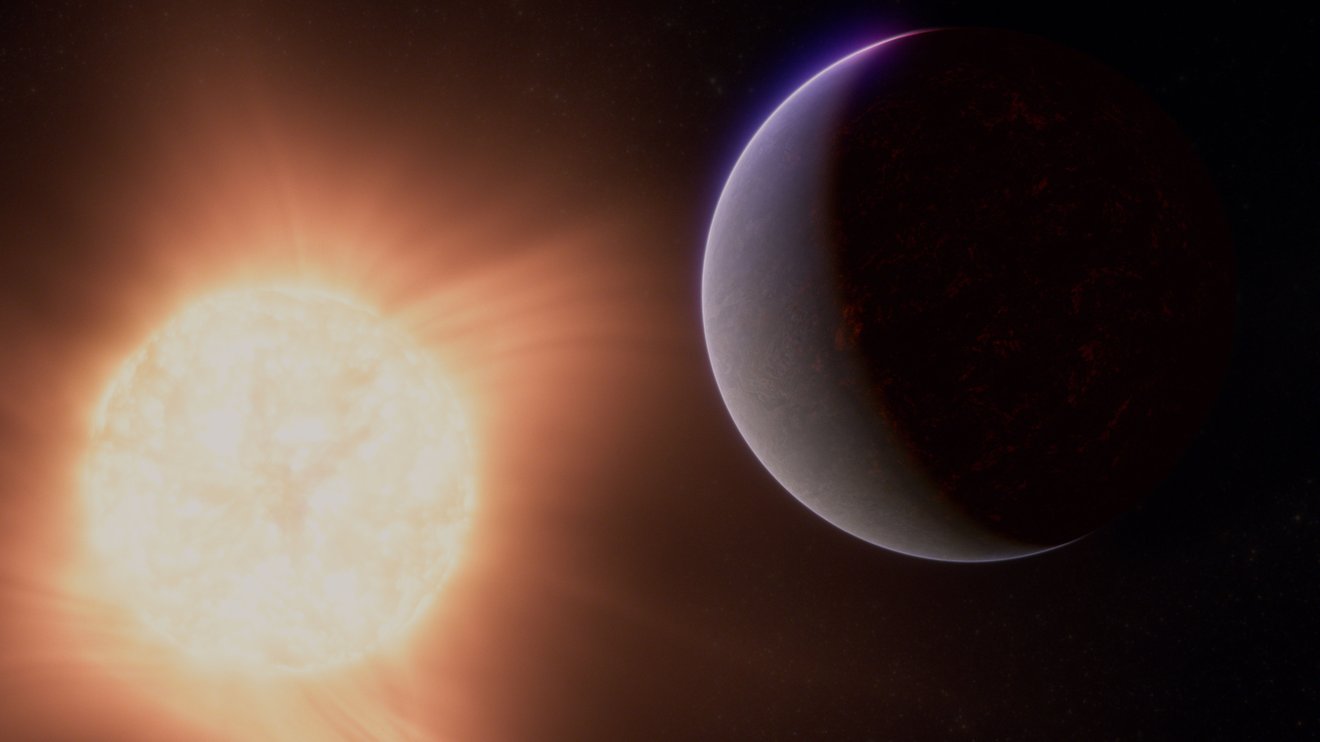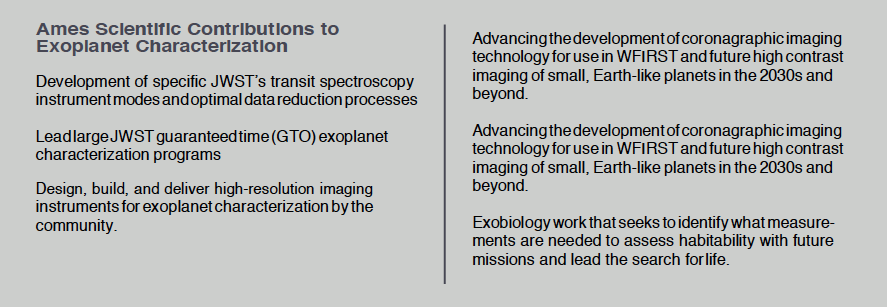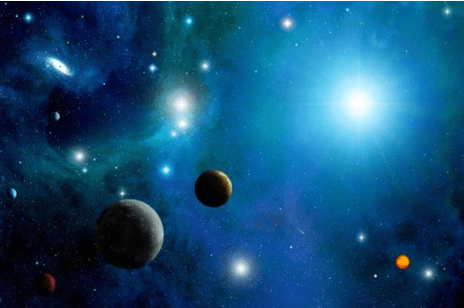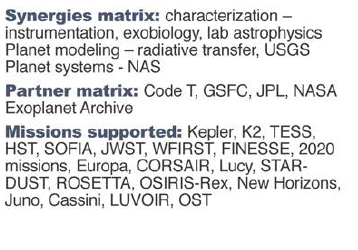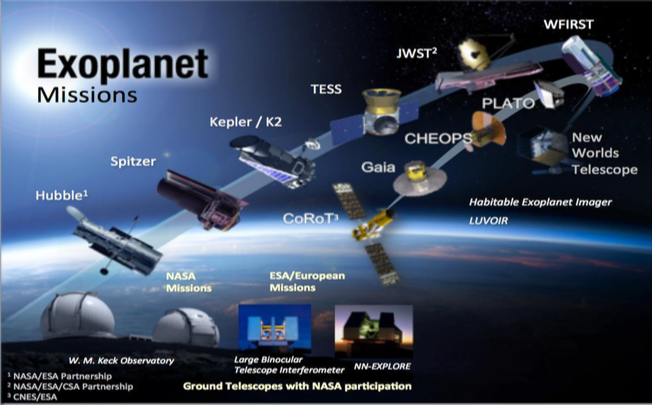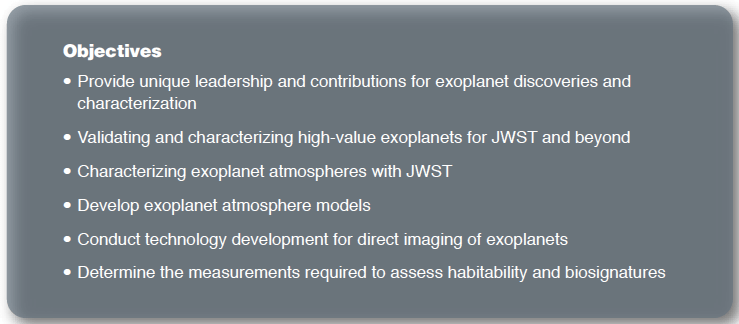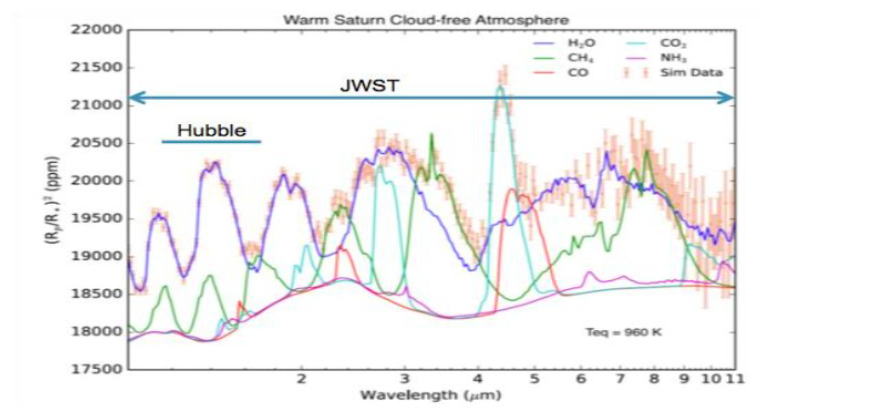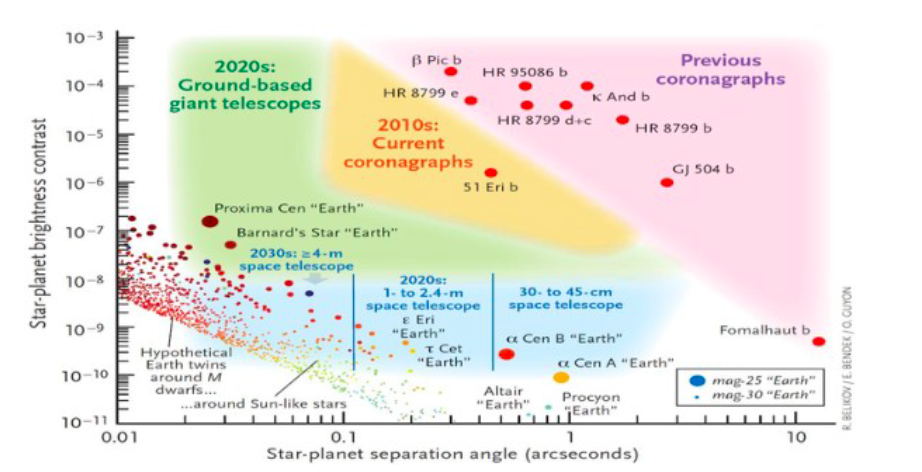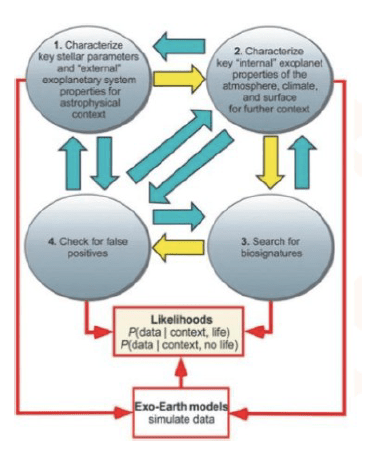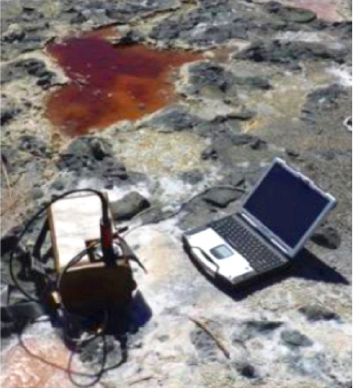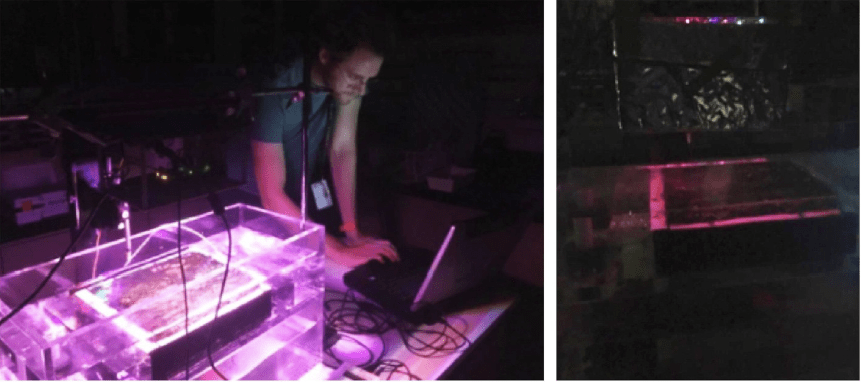Core Capability 3 – Exoplanet Characterization; Enabling NASA’s Search for Life
Exoplanet Characterization Highlights
There are now over 4000 confirmed planets listed in the NASA Exoplanet Archive, and most of these were discovered via the Ames-conceived Kepler/K2 missions. We now know that most planetary systems are different from our own and the most common type planet is not one we have in our solar system. The TESS mission is now finding more transiting planets, many around nearby bright stars that are amenable to detailed characterization. The upcoming James Webb Space Telescope and Wide Field Infrared Survey Telescope missions will further add to our knowledge of exoplanets and open new windows for exoplanet characterization through spectroscopy and direct imaging observations. Ames scientists are leading important efforts to facilitate characterization of the exoplanet discoveries and helping to enable NASA’s search for life in the universe.
Major Division efforts include developing an innovative high-resolution imaging capability to allow correct measurements of exoplanet radii, which lead to improved occurrence rates and atmospheric studies as well as a better understanding of exoplanetary system formation and evolution. Ames scientists are also leading efforts to characterize exoplanets through JWST spectroscopic observations using detailed atmospheric models and spectral retrieval techniques. New modeling techniques, including innovative treatments for clouds and hazes, are being developed to enable the interpretation of spectroscopic data from both JWST and WFIRST. Robust spectral characterization of a variety of exoplanets is needed to ultimately understand their diversity, formation, evolution, and how they relate to our own solar system and its planets, ultimately including Earth. Additionally, spectroscopy and direct imaging are critical in the search for biosignatures and life elsewhere in the Galaxy. These efforts are deemed as critical needs in New Worlds, New Horizons, the 2010 Decadal Survey, and the 2014 NASA strategic Science Plan. We anticipate similar needs will be highly ranked in the Astro2020 Decadal Survey as well.
In addition, Ames scientists are contributing to the scientific success of the Kepler/K2, TESS, JWST, WFIRST, and other NASA exoplanet mission concepts through unique ground-based mission support observations, exoplanet atmospheric modeling efforts, and community science activities for JWST, WFIRST, and beyond. Ames scientists develop and contribute valuable exoplanet related data, data products, and software tools to the community via public archives. These diverse, multi-faceted, and substantive efforts will help ensure that NASA will successfully meet its exoplanet discovery and characterization goals in the 2020s and beyond.
Objective 3.1 – Provide Unique Leadership and Contributions for Exoplanet Discoveries and Characterization
Our goal in exoplanet studies is to expand Agency capabilities to characterize exoplanets with both ground and space-based telescopes and instrumentation – leading to a better understanding of exoplanet radii, mean densities, atmospheric compositions, planetary architectures, formation and evolution scenarios, planet occurrence rates, direct imaging technologies, and remote detection of the signatures of life. These areas of research are deeply interdisciplinary across the ARC Space Science and Astrobiology Division. ARC scientists are leading major programs in high-resolution imaging, IR spectroscopy, model atmosphere calculations, experimental and theoretical laboratory astrophysics atmospheric and surface studies, and biosignatures for remote sensing life detection. New directions in the Agency plan to examine exoplanet atmospheric structures utilizing global circulation model (GCM) expertise developed at Ames for Mars and for other solar system planets. Additionally, large space missions being studied for the 2030s (LUVOIR, HabEx, OST) are focusing on characterizing the atmospheres of habitable worlds, and Ames will continue work on exoplanet imaging technologies and far-IR observations that will enable JWST, WFIRST, and future missions to fully exploit exoplanet science.
We also incorporate the significant expertise Ames has in laboratory astrophysics, radiative transfer processes and modeling, and exobiology into the broader theme of exoplanet characterization and the search for life. This cross-cutting effort provides a near-term community resource as well as a longer-term Agency capability to advance the design and requirements for future NASA missions (Figure 3.1) and prepare the NASA community to fully exploit their data.
Objective 3.2 – Validating and Characterizing High-value Exoplanets for JWST and Beyond
Ames scientists provide an unparalleled resource for detailed analyses in the key area of high-resolution exoplanet host star imaging. The exoplanet community is in the midst of identifying as many planet candidates as possible while beginning to characterize individual systems in order to understand both the diversity of planets as well as the formation mechanisms involved. High-resolution exoplanet speckle imaging, pioneered at and unique to Ames, makes a significant contribution to this work and has become the standard technique to validate and characterize exoplanet candidates. This capability addresses six of the twelve science gap areas identified by the community and tallied by the Exoplanet Program Office (ExPO). Not only does this program identify false positives and validate exoplanets, it provides the only method of assessing critical physical parameters for the exoplanets discovered. All reduced data and data products are sent to the NASA Archives for immediate use by the community. These data are required in order to determine the correct radius of any exoplanet discovered by the transit technique, without which the calculated mean density and atmospheric structure (scale height) will be unknown or incorrect. Such characterization is especially critical for small, rocky planets in long period orbits, which are not amenable to RV mass determinations or any form of direct imaging. These “earth-like” exoplanets will be the prime targets in the search for life and their physical characteristics are of key importance. Incorrect planetary radii can also give rise to systematic errors in star and planet counts, which lead to biases in planet occurrence rates. In particular, occurrence rates of planets with radii less than approximately 2 Earth-radii, a key regime for understanding the formation and evolution of rocky super-Earths and sub-Neptunes with thick atmospheres, may be underestimated by as much as 50%.
Objective 3.3 – Characterizing Exoplanet Atmospheres with JWST
JWST will drive the field of exoplanet atmospheric studies for the next decade. Hubble Space Telescope observations have shown us that H2O is common in giant planet atmospheres, and that high-altitude clouds are often detected in emission spectra. JWST will allow precision determinations of molecular content in giant planets, expanding from only H2O to include CO, CO2, CH4, NH3, and other species (e.g., photochemical products) as can be seen (Figure 3.3). Such observational discoveries will greatly inform the formation and thermo-chemical structures of exoplanets. JWST’s sensitivity will enable expanding atmospheric analyses to planets that are Neptune mass or below.
Recent work at Ames has shown that multi-wavelength 1 to 11 micron transmission or emission spectral observations will be required to characterize the compositions, metallicities, and C/O ratios in cloudy or high mean molecular weight atmospheres of warm exoplanets. Ames scientists are leading over 200 hours of JWST GTO programs that will characterize the atmospheres of 8 mostly warm (400 – 850 K), low-mass (Earth mass to Saturn mass) exoplanets. These observations will be among the first exoplanet spectroscopy programs conducted by JWST. Our design of the instrumental modes used in these observations and the analysis of their data will inform the community about exoplanet compositions, formation, and evolution as well as provide a template for further observations and archival data use.
Objective 3.4 – Develop Exoplanet Atmosphere Models
The interpretation of and planning for spectroscopic observations of exoplanet atmospheres relies upon our understanding of the atmospheric structure, composition, clouds, hazes as well as the global atmospheric dynamics of the studied exoplanets. The traditional method of pursuing such studies has been to construct ‘forward models’ of atmospheric structure which combine assumptions about the atmosphere with sophisticated radiative transfer atmosphere software models. In the past half dozen years, ‘retrieval’ methodology, pioneered in the Earth sciences community, has seen a major ascendance as the current method of choice for atmospheric studies. In this approach, hundreds of thousands to millions of models are computed on a supercomputer and directly compared to observational data. Those sets of model parameters that best fit the dataset, provides a rigorous description of the information content of the data. New retrieval efforts and methodologies are needed to support the types of space-based exoplanet observations expected in the coming decade.
Clouds and hazes populate every solar system atmosphere and have been demonstrated to be present in exoplanet atmospheres as well. These common atmospheric entities can block radiation from deeper atmospheric levels and through scattering can complicate retrievals of atmospheric abundance. Clouds and hazes are also tracers of atmospheric dynamics. Thus, to fully characterize exoplanet clouds, they must be accounted for in both retrieval and forward models of exoplanet atmospheres. Any characterization of habitable planets, for example, will be definition entail accounting for water clouds. Studies of clouds in the atmospheres of other types of exoplanets will inform habitability research and build the foundation needed by the future space telescope missions in their search for life.
Objective 3.5 – Conduct Technology Development for Direct Imaging of Exoplanets
Several planets or “planetary-mass objects” have already been directly imaged with coronagraphs from space and from the ground as shown in the right-hand corner of Figure 3.5.
NASA’s next flagship telescope after the James Webb Space Telescope (JWST) is likely to be WFIRST (Wide-Field Infrared Survey Telescope) and will have a coronagraphic instrument for direct imaging of exoplanets. It is currently not designed to be capable of directly imaging potentially habitable worlds, but with future advances in post-processing or starshades such detection is not entirely out of the question. The telescope will be 2.4m in size and is scheduled to launch in 2024. NASA is also currently undergoing four studies of large flagship missions for the 2030s, two of which (Habitable Exoplanet Imaging Mission or HabEx, and Large UV/Optical/IR Surveyor, or LUVOIR) are designed to be capable of detecting and spectrally characterizing a statistically significant number of exo-Earths, as well as many larger planets.
If there is a planet around Alpha Centauri, it is in principle possible to detect and take a low-resolution spectrum with a very small 30-45cm space telescope, due to Alpha Centauri being ~3x closer to the Sun than any other Sun-like star. As can be seen in Figure 3.5, Alpha Centauri is an extreme outlier and “low-hanging fruit”.
The Technology that will be enabled at Ames is:
- Direct imaging with a small (30-50cm) space telescope. ARC is pioneering the idea of imaging exoplanets in the Alpha Centauri system with a small space telescope, with several related mission concepts that have been developed or are under development, such as ACESat and Project Blue.
- Direct imaging with a large telescope such as WFIRST, LUVOIR, and HabEx. ARC is leading the development of Multi-Star Wave Front Control, which can enable all of the above missions to target binary stars such as Alpha Centauri. This enables increases in both the quantity of targets, as well as the quality of the signal. In addition, ARC is leading the lab development of the PIAA coronagraph, which is a candidate for LUVOIR and HabEx.
- Assess the scientific potential of astrometry to detect and measure exoplanet masses around nearby F, G, and K stars. Determine the mass measurement accuracy necessary to assess atmosphere retention capability of a planet; this is necessary to inform the design of future exoplanet flagship missions.
- Additional interesting science observations which ARC is well suited to do include: direct imaging of potentially habitable planets in 10 microns (with JWST); precursor observations of the Alpha Centauri system such as exozodi with GPI / SPHERE, and the galactic background to assess confusion risk.
Objective 3.6 – Determine the Measurements Required to Assess Habitability and Biosignatures
Work in the Exobiology Branch at Ames focuses on the characterization of novel gaseous and surface biosignatures in analog field settings and in laboratory simulations. Beyond identifying new biosignatures, this work is integrated into modeling activities at Ames and with other external partners to assess their remote detectability to aid in target selection, and into frameworks for biosignatures assessment for life detection. Such frameworks will need to consider the context of the stellar and planetary environment, and provide a way to assess false positives and false negatives before arriving at a convincing interpretation of the presence of life (Figure 3.6a).
Experimental work centers around field and lab campaigns to measure gaseous and surface biosignatures associated with anoxic biospheres. The study of potential exoplanet biosignatures — the global impact of life on a planetary environment — has been informed primarily by the modern Earth, with little yet explored beyond atmospheric O2 from oxygenic photosynthesis and its accompanying planetary surface feature, the vegetation “red edge” reflectance.
However, these biosignatures have only been present for less than half the Earth’s history, and recent geochemical evidence suggests that atmospheric O2 may have been at very low – likely undetectable – levels, until 0.8 Ga (Planavsky et al., 2014). Given that our planet was inhabited for very long periods prior to the rise of oxygen, and that a similar period of anoxic life may occur on exoplanets, more studies are needed to characterize remotely detectable biosignatures associated with more evolutionarily ancient anoxygenic phototrophs and anaerobic chemotrophs. We are quantifying biogenic gas production in natural systems and in laboratory environmental chambers where we control the composition of the atmosphere and stellar irradiance. The suite of biogenic gases will then be fed into atmospheric models to assess the potential photolytic destruction and production of secondary biosignatures.
We are also measuring the reflectance spectra of anoxygenic phototrophs (Fig. 3.6b) and assessing their detectability under different atmospheric compositions and cloud coverage levels. While we focus on characterizing anoxic biosignatures, oxygen remains a key biosignature gas, so we are also assessing the productivity and detectability of oxygenic photosynthesis around cool M dwarf stars (Figure 3.6c). Given the low photon flux in the visible wavelengths, this may limit photosynthetic productivity and significant inhibit oxygen build-up in the atmosphere to detectable levels (Lehmer, et al., 2018).
Ames Exobiology researchers plan to serve as leaders and coordinators for expanding the engagement of biologists in exoplanet biosignatures research by providing guidance on how to modify their research methodologies to make them applicable to exoplanets. Additionally, input from the ‘origins of life’ exobiologists is needed in order to predict potential prebiotic chemistry and metabolisms on planets with different chemical compositions than the early Earth (e.g., a highly reducing planet).




